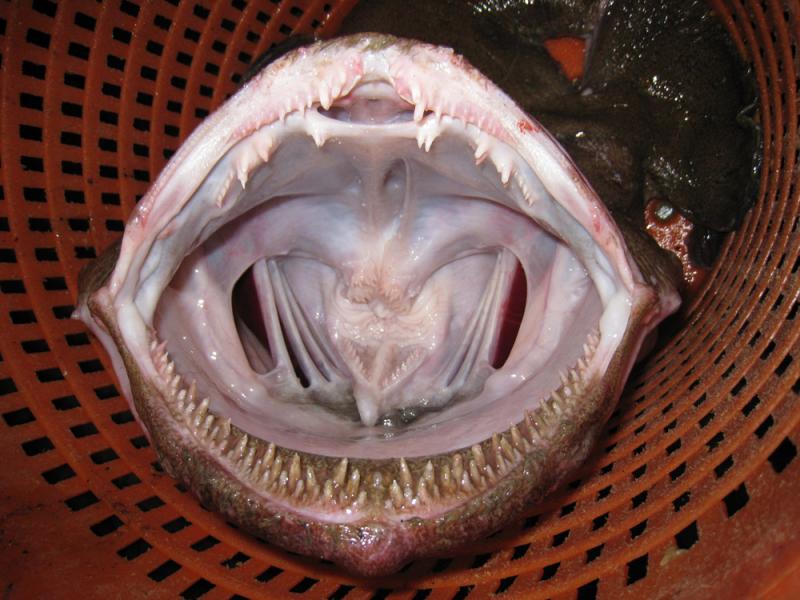Three new cooperative research projects announced today will improve understanding of monkfish biology and how to reduce catch of skates in monkfish gillnet gear.
The projects are possible because of an innovative program established by the New England and Mid-Atlantic Fishery Management Councils, and managed by NOAA Fisheries in the region. Under it, monkfish fishing days are set-aside each year and revenue generated from the sale of those days are used to pay for research projects.
Award recipients for the 2018-2019 Monkfish Research Set-Aside (RSA) Program include the Coonamessett Farm Foundation, Cornell Cooperative Extension of Suffolk County, and the University of New England.
The monkfish resource is one of the region’s most valuable, hauling in approximately $20 million in landings in 2016. Monkfish, or goosefish, are familiar to many people as “anglers”; a fish with a built-in lure that helps it attract prey. This filament is really a spine that’s part of its dorsal fin. It extends out from the middle of the fish’s head and has a frothy-looking ray at its end that looks like a tasty morsel to passing prey. Monkfish are mostly mouth with a meaty tail and a stomach that can expand enough to take in prey that are as large as the fish itself. The tail is the part fishermen, and seafood lovers, prize.
Using Ultrasound to “See” More About Monkfish
The Coonamessett Farm Foundation was awarded 296 monkfish RSA days-at-sea to conduct a 2-year study. They plan to test ultrasound methods for determining sex and maturity stage in Southern New England monkfish, and to conduct hormone analyses to create a reproductive profile based on sex and maturity stage of monkfish.
Reducing Skate Bycatch
The Cornell University Cooperative Extension of Suffolk County was awarded 303 monkfish RSA days-at-sea to conduct a 2-year experiment evaluating a modified gillnet designed to reduce skate bycatch. Monkfish vessels also have a skate quota. If that quota is caught too quickly, it can constrain monkfish trips for the remainder of a fishing year. Researchers hope to find a gear solution that will reduce skate in the catch without affecting monkfish harvest rates.
Reading Age from a Backbone and a Filament
The University of New England was awarded 401 monkfish RSA days-at-sea to conduct a 2-year study using histological ageing techniques on monkfish vertebrae (backbones) and illicia (the fish's built-in "lures"). The proposed approach yielded promising results in pilot research done through a previous monkfish RSA project where histological staining — using special dyes to bring out underlying tissue structures and condition — was applied to monkfish vertebrae. Annual growth rings could be clearly seen. This work will validate these earlier, preliminary results and also test the method on illicia. The research team will also collect reproductive data to estimate age and size at maturity.
More About the RSA Program
The New England and Mid-Atlantic Fishery Management Councils have joint responsibility for developing a management plan for this fishery. That plan currently limits the number of days that the fleet can spend targeting this species. Under this program, 500 days-at-sea are “set aside” annually by the councils and then awarded through a federal grant competition to projects that address monkfish research priorities.
No federal funds are provided for research under this program, nor does NOAA Fisheries retain or use funds derived from the sale of research set-aside days-at-sea. Rather, the research is paid for by revenue generated from these days. NOAA Fisheries manages the competition, oversees research activities, and monitors the use of RSA days-at-sea.
In addition to the monkfish RSA program, there are active RSA programs for Atlantic sea scallop and Atlantic herring. These programs support applied research that responds to priorities established by the regional fishery management councils, and are designed to inform resource management decisions and improve stock assessments.
For more information about research funded through the region’s RSA programs, visit the program's webpage or contact Ryan Silva.
2018-2019 Monkfish Research Set-Aside Projects
| Institution | Project Title | 2 Year DAS Allocations |
|---|---|---|
| Coonamessett Farm Foundation | Exploring Non-Lethal Techniques for Sex Determination and Evaluation of Maturity Stage of Southern New England Monkfish, Lophius americanus | 296 DAS Est. value: $1,559,411 Research cost: $121,189 |
| Cornell Cooperative Extension | Increasing Twine Thickness and Mesh Size to Reduce Skate Bycatch in Monkfish Sink Gillnets |
303 DAS |
| University of New England | Development of a Histological Protocol for the Age Determination of Monkfish, Lophius americanus | 401 DAS Est. value: $2,109,346 Research cost: $163,927 |

